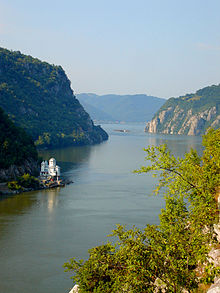Names[edit]
In English, the gorge is known as Iron Gates or Iron Gate. An 1853 article about the Danube in The Times of London referred to it as "the Iron Gate, or the Gate of Trajan."[1]
In languages of the region including Romanian, Hungarian, Slovak, Turkish, German and Bulgarian, names literally meaning "Iron Gates" are used to name the entire range of gorges. These names are Romanian: Porțile de Fier (pronounced [ˈport͡sile de ˈfjer]), Hungarian: Vaskapu, Slovak: Železné vráta; Turkish: Demirkapı, German: Eisernes Tor, and Bulgarian: Железни врата (Železni vrata). An alternative Romanian name for the last part of the route is Defileul Dunării, literally "Danube Gorge".
In Serbian, the gorge is known as Đerdap (Ђердап; [d͡ʑě̞rdaːp]), with the last part named Đerdapska klisura (Ђердапска клисура; [d͡ʑě̞rdaːpskaː klǐsura]) from the Byzantine Greek Κλεισούρα (kleisoura), "enclosure" or "pass."
Gorges[edit]
The first narrowing of the Danube lies beyond the Romanian isle of Moldova Veche and is known as the Golubac gorge. It is 14.5 km long and 230 m (755 ft) wide at the narrowest point. At its head, there is a medieval fort at Golubac, on the Serbian bank. Through the valley of Ljupovska lies the second gorge, Gospodjin Vir, which is 15 km long and narrows to 220 m (722 ft). The cliffs scale to 500 m and are the most difficult to reach here from land. The broader Donji Milanovac forms the connection with the Great and the Small Kazan gorge, which have a combined length of 19 km (12 mi). The Orșova valley is the last broad section before the river reaches the plains of Wallachia at the last gorge, the Sip gorge.
The Great Kazan (kazan meaning "cauldron" or "reservoir") is the most famous and the most narrow gorge of the whole route: the river here narrows to 150 m and reaches a depth of up to 53 m (174 ft). East of this site the Roman emperor Trajan had built the legendary bridge erected by Apollodorus of Damascus. Construction of the bridge ran from 103 through 105, preceding Trajan's final conquest of Dacia. On the right (Serbian) bank a Roman plaque commemorates him. On the Romanian bank, at the Small Kazan, the likeness of Trajan's Dacian opponent Decebalus was carved in rock from 1994 through 2004.
Significantly older discoveries have been found in the geographically less spectacular gorge of Gospodjin Vir: in the 1960s the archaeological site Lepenski Vir was unearthed, the most important in all of southeastern Europe. The sandstone statues dated to the early neolithic era are particularly splendid. Together with many other findings in the Iron Gates gorges area, they indicate that the region has been inhabited for a very long time.
Channel[edit]
The riverbed rocks and the associated rapids made the gorge valley an infamous passage for shipping. In German, the passage is still known as the Kataraktenstrecke, even though the cataracts are gone. Near the actual "Iron Gates" strait the Prigrada rock was the most important obstacle until 1896: the river widened considerably here and the water level was consequently low. Upstream, the Greben rock near the "Kazan" gorge was notorious.
In 1831 a plan had already been drafted to make the passage navigable, at the initiative of the Hungarian politician István Széchenyi. Finally Gábor Baross, Hungary's "Iron Minister", succeeded in financing this project.
In 1890, near the city of Orsova (in Hungarian; Ursa in Romanian) being the last border town of Hungary, rocks were cleared by explosion over a 2 km (1.2 mi) stretch in order to create an 80 m (262 ft) wide and 3 m (10 ft) deep channel. A spur of the Greben Mountains was removed across a length of over 2 km (1.2 mi). Here, a depth of 2 m (7 ft) sufficed. On 17 September 1896, the Sip Channel thus created (named after the Serbian village on the right bank) was inaugurated by the Austro-Hungarian emperor Franz Joseph, the Romanian king Carol I, and the Serbian king Alexander Obrenovich.
The results of these efforts were slightly disappointing. The currents in the channel were so strong that, until 1973, ships had to be dragged upstream by locomotive. The Iron Gates thus remained an obstacle of note.




No comments:
Post a Comment